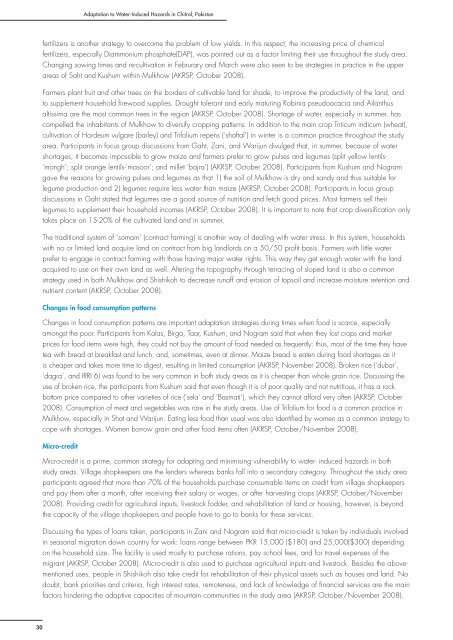Full Document - Himalayan Document Centre - icimod
Full Document - Himalayan Document Centre - icimod
Full Document - Himalayan Document Centre - icimod
You also want an ePaper? Increase the reach of your titles
YUMPU automatically turns print PDFs into web optimized ePapers that Google loves.
Adaptation to Water-Induced Hazards in Chitral, Pakistanfertilizers is another strategy to overcome the problem of low yields. In this respect, the increasing price of chemicalfertilizers, especially Diammonium phosphate(DAP), was pointed out as a factor limiting their use throughout the study area.Changing sowing times and re-cultivation in Februrary and March were also seen to be strategies in practice in the upperareas of Saht and Kushum within Mulkhow (AKRSP, October 2008).Farmers plant fruit and other trees on the borders of cultivable land for shade, to improve the productivity of the land, andto supplement household fi rewood supplies. Drought tolerant and early maturing Robinia pseudoacacia and Ailanthusaltissima are the most common trees in the region (AKRSP, October 2008). Shortage of water, especially in summer, hascompelled the inhabitants of Mulkhow to diversify cropping patterns. In addition to the main crop Triticum indicum (wheat),cultivation of Hordeum vulgare (barley) and Trifolium repens (‘shaftal’) in winter is a common practice throughout the studyarea. Participants in focus group discussions from Gaht, Zani, and Warijun divulged that, in summer, because of watershortages, it becomes impossible to grow maize and farmers prefer to grow pulses and legumes (split yellow lentils-’mongh’; split orange lentils-‘masoor’; and millet ‘bajra’) (AKRSP, October 2008). Participants from Kushum and Nogramgave the reasons for growing pulses and legumes as that 1) the soil of Mulkhow is dry and sandy and thus suitable forlegume production and 2) legumes require less water than maize (AKRSP, October 2008). Participants in focus groupdiscussions in Gaht stated that legumes are a good source of nutrition and fetch good prices. Most farmers sell theirlegumes to supplement their household incomes (AKRSP, October 2008). It is important to note that crop diversifi cation onlytakes place on 15-20% of the cultivated land and in summer.The traditional system of ‘somain’ (contract farming) is another way of dealing with water stress. In this system, householdswith no or limited land acquire land on contract from big landlords on a 50/50 profi t basis. Farmers with little waterprefer to engage in contract farming with those having major water rights. This way they get enough water with the landacquired to use on their own land as well. Altering the topography through terracing of sloped land is also a commonstrategy used in both Mulkhow and Shishikoh to decrease runoff and erosion of topsoil and increase moisture retention andnutrient content (AKRSP, October 2008).Changes in food consumption patternsChanges in food consumption patterns are important adaptation strategies during times when food is scarce, especiallyamongst the poor. Participants from Kalas, Birga, Taar, Kushum, and Nogram said that when they lost crops and marketprices for food items were high, they could not buy the amount of food needed as frequently: thus, most of the time they havetea with bread at breakfast and lunch; and, sometimes, even at dinner. Maize bread is eaten during food shortages as itis cheaper and takes more time to digest, resulting in limited consumption (AKRSP, November 2008). Broken rice (‘dubar’,‘dagra’, and IRRI 6) was found to be very common in both study areas as it is cheaper than whole grain rice. Discussing theuse of broken rice, the participants from Kushum said that even though it is of poor quality and not nutritious, it has a rockbottom price compared to other varieties of rice (‘sela’ and ‘Basmati’), which they cannot afford very often (AKRSP, October2008). Consumption of meat and vegetables was rare in the study areas. Use of Trifolium for food is a common practice inMulkhow, especially in Shat and Warijun. Eating less food than usual was also identifi ed by women as a common strategy tocope with shortages. Women borrow grain and other food items often (AKRSP, October/November 2008).Micro-creditMicro-credit is a prime, common strategy for adapting and minimising vulnerability to water- induced hazards in bothstudy areas. Village shopkeepers are the lenders whereas banks fall into a secondary category. Throughout the study areaparticipants agreed that more than 70% of the households purchase consumable items on credit from village shopkeepersand pay them after a month, after receiving their salary or wages, or after harvesting crops (AKRSP, October/November2008). Providing credit for agricultural inputs, livestock fodder, and rehabilitation of land or housing, however, is beyondthe capacity of the village shopkeepers and people have to go to banks for these services.Discussing the types of loans taken, participants in Zani and Nogram said that micro-credit is taken by individuals involvedin seasonal migration down country for work: loans range between PKR 15,000 ($180) and 25,000($300) dependingon the household size. The facility is used mostly to purchase rations, pay school fees, and for travel expenses of themigrant (AKRSP, October 2008). Micro-credit is also used to purchase agricultural inputs and livestock. Besides the abovementioneduses, people in Shishikoh also take credit for rehabilitation of their physical assets such as houses and land. Nodoubt, bank priorities and criteria, high interest rates, remoteness, and lack of knowledge of fi nancial services are the mainfactors hindering the adaptive capacities of mountain communities in the study area (AKRSP, October/November 2008).30
















